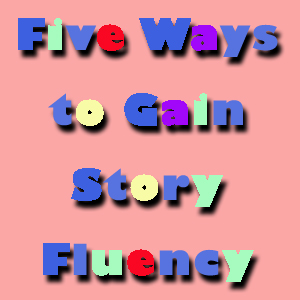Every time I blink these days I see another article on story. It’s something of a too popular buzzfad, but for good reason. Clearly, story is important in many aspects of marketing, communication, and innovation. The current literature tends to focus on understanding story, and, aligning a story with a brand, or an organization.
There is also the related trend of story telling, ala The Moth. I’ve been involved this last year with a similar regional group, Indigan Storyteller here in Michiana, and its been a transformative experience. I’ve written a business novel (Jack’s Notebook) and I can tell you this, I’m still learning to create and tell stories.
Story is a saw we can all sharpen.
What doesn’t seem to be covered in the new literature is the concept of story fluency. I’m convinced that understanding, creating, and communicating a story is only done well if one has story fluency. For Five Ways to Gain Story Fluency, see my list below, but first…
Can we agree that getting a story right — even a true life story — is difficult? If it was easy there wouldn’t be so many articles written, workshops and course offerings about How To. People are seeking story fluency, even if it’s not called that. A workshop can get you started on fluency, but only just. Gaining story fluency, just like guitar playing, only happens with regular practice. I know lots of guitar chords but smooth switching from one to another is not there for me because I don’t practice enough. The same is true for story. Like a song, a story has a structure and it’s important to understand that structure if you want to sing it/tell it well. My KILN partner Kate Hammer, Phd has an excellent method for analyzing context and creating story in her StoryFORMs tool. I would call StoryFORMs a story fluency tool.
What is story fluency? It’s the ability to generate stories, for various purposes, quickly and easily. In addition, it’s the ability to examine story options and pick the one that is most authentic and suited to purpose. Fluency means generating lots of story versions and variations. This divergent thinking is important because getting a story right means experimenting with story content, meaning, and, how to tell it. Simply put, it’s about the getting the right words in the right order. The convergent thinking piece of evaluating which specific way to tell a story is most appropriate, is critical. It’s critical because all the versions in the world won’t do you any good if you don’t select the most appropraite one.
The link to innovation is this: a poorly told story about a new product, company policy change, a new service, a brand re-introduction, a process improvement, or even your personal life choices — is likely to fail. It’s quite sad to see a good idea flop at the last second because it hasn’t been positioned well.
I’ll say it again, gaining story fluency only happens with practice. If you want to leverage the power of story, you have to practice.
Like so many creative endeavors, many of us are prone to try to get things right with a story immediately out of the gate. It’s unlikely you will get it right the first time, and, our tendency is to criticize ourselves when we don’t. Of course, this negative mindset makes it less likely your second version will be full of life and self-expression. Like all things creative, it’s best to diverge first and converge afterwards…anyway, here are:
Five Ways to Gain Story Fluency
- Build Awareness of Story. As you go through your day, asking yourself what’s the story related to the things you see and hear. What’s the story behind that brand of bread you toast? What’s the story of the radio show you listen to? What’s your own story? What’s your story related to exercise? There is a story behind everything, build awareness by paying attention. Listen to The Moth Story Hour.
- Understand the basics of story structure. There’s more to story than beginning, middle, and end. Knowing how stories tend to work will enhance your own ability to create dynamic stories that conform to social expectations.
- When articulating a new story, try several versions with friendly listeners. This is the divergent piece, don’t be in a hurry to get it down pat in a day — you’ll learn something each time you tell a story. As you tell your story, notice what people respond to, notice where in a story you get the “doe eyes.” Adapt and revise your story. Try again. With complex messages you’ll need to do this many times. Be patient, you’ll get there. Experiment, play.
- When selecting a story version, have clear criteria for selection, then choose. What do you need your story to accomplish? Is it brand awareness? Is it empathy? Humor? Is it a link to corporate values? Work through your criteria, then pick the story version that fits best. Be thoughtful and don’t rule out the radically different until you’ve given yourself time to get used to that very different version of the story.
- Practice storytelling before it’s an emergency. If you wait to create and tell a story until that moment when you are in desperate need, you’ll not be ready. Tell stories for the fun of it, all the time, and you’ll be ready when the moment comes. Try out various forms of storytelling, in writing, on stage, in small groups, one on one, via Twitter, video etc.
So tell your story, and tell it often.



